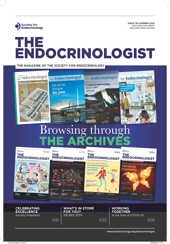FIRST PUBLISHED IN ISSUE 125 (2017)
Since the 1890s, when George Redmayne Murray first used sheep thyroid extract, the principles of thyroid hormone replacement in hypothyroid patients have remained quite constant. The utilisation of pharmacologically produced thyroid hormones has vastly improved care, but considerable controversy still exists over the role of therapy with thyroxine (T4) and tri-iodothyronine (T3) together versus T4 alone in order to better mimic endogenous production. While better designed clinical trials in the future may improve exogenous thyroid hormone therapy, new advances in understanding thyroid development offer the potential to develop thyroid gland regeneration as an alternative for patients.
FOLLICULAR CELL DEVELOPMENT
The follicular cell of the thyroid is responsible for the synthesis of both T4 and T3. Its development from endoderm requires the expression of two transcription factors, Nkx2-1 and Pax8. Indeed, mutation of either leads to congenital hypothyroidism in humans. Interestingly, both Nkx2-1 and Pax8 are expressed in other cell types, but it is their coexpression in anterior endoderm that leads to the development of the follicular cell.
Clearly, factors required for thyroid gland development go well beyond these two proteins, and include a number of other transcription factors as well as the external milieu where the gland develops. Importantly, advances in embryonic stem cell (ESC) and induced pluripotent stem cell (iPSC) technology have had a significant impact on our understanding of follicular cell development and have opened up the future possibility of regenerative therapy for hypothyroidism.
In order to induce thyroid development from murine ESCs, investigators initially used a variety of techniques, including generating ESCs that possess a labelled thyrotrophin (TSH) receptor, so that cells poised to differentiate appropriately could be identified.1 While such techniques produced follicular-like structures in culture, it was not clear if they had the capacity to produce thyroid hormones.

In vitro development of ESC-derived thyroid follicular cells by directed differentiation: immunofluorescence microscopy of day 30 follicular-like structures after immunostaining for Nkx2-1 and thyroglobulin (Tg). Nuclei are counterstained with DAPI; scale bars 10µm. Reproduced with permission from Figure 5F, Kurman et al. 2015 Cell Stem Cell 17 527 542
CREATING FUNCTIONAL FOLLICLES
The first major breakthrough in this area was made by the laboratory of Sabine Costagliola, who co-expressed Nkx2-1 and Pax8 at a very early stage of mouse ESC development.2 By then adding TSH and providing a 3D culture system, these ESCs were able to develop into follicular structures that expressed thyroglobulin and also had the ability to take up iodine – a crucial step in thyroid hormone biosynthesis. More remarkably, when transplanted into athyreotic mice, these follicles fully functioned to restore normal thyroid hormone synthesis. These experiments proved that regenerative therapy for hypothyroidism was a possibility but, because of the transcription factor overexpression strategy employed, would probably not be clinically applicable.
To identify the actual differentiation pathway employed by ESCs or iPSCs to become follicular cells, our group has used a directed differentiation approach that uses growth factors thought to play a role in thyroid gland development in vivo. To enhance our ability to detect endodermal cells that are destined to become follicular cells, we labelled the Nkx2-1 locus with a fluorophore, such that cells appearing green or red could be identified as expressing Nkx2-1.3 Using this technique we were able to identify that the growth factors bone morphogenic protein 4 (BMP4) and fibroblast growth factor 2 (FGF2) were absolutely required for endoderm derived from mouse ESCs to become thyroid follicular cells. Furthermore, both BMP4 and FGF2 appeared to play a similar role in Xenopus, suggesting that this pathway is conserved across species.
Once specified with BMP4 and FGF2, Nkx2-1 positive cells could then be further differentiated in a 3D culture system into follicular units that expressed all important thyroid markers, including thyroglobulin, and more importantly had the ability to synthesise small amounts of T4.
SEEKING SUCCESS IN VIVO
To prove these cells could function in vivo, we transplanted ESC-derived follicles after 30 days in culture into the kidney capsule of mice that had previously been given 131I to render them hypothyroid. At 2 weeks after transplantation, T4 began to reappear in the transplanted mice, and by 8 weeks almost all transplanted mice had become euthyroid. Importantly, the TSH set point returned to its pre-hypothyroid setting, demonstrating that the transplanted cells were entirely TSH-responsive.
‘Given the progress in the field, it is fully expected that a directed differentiation approach using human iPSCs should be possible and that transplantable follicles will be produced.’
Further testing showed that these cells could take up iodine and also be kept in place for a number of months without any abnormal growth. Thus, this protocol further demonstrated the possibilities for the development of regenerative therapy, using an approach that does not require modification of ESCs or iPSCs.
While the protocols developed using mouse ESCs have provided key insights into thyroid follicular cell development, the important next steps must occur in human ESC or iPSC models. Our group has shown that human iPSCs can be induced to express thyroid markers but, to date, functionality in vitro or in vivo is lacking. However, given the progress in the field, it is fully expected that a directed differentiation approach using human iPSCs should be possible and that transplantable follicles will be produced.
Clearly, the development of such cells from human iPSCs will only be the beginning of a long road of testing to determine whether such an approach could ever be used to repair hypothyroidism in our patients. Still these cells and the biologic processes that control their differentiation should provide ideal model systems to study the thyroid and its diseases for years to come.
Anthony N Hollenberg, Currently Sanford I Weill Chair of Medicine and Professor of Medicine at Weill Cornell Medical College, New York, NY, USA
REFERENCES
- Arufe MC et al. 2006 Endocrinology 147 3007–3015.
- Antonica F et al. 2012 Nature 491 66–71.
- Kurmann AA et al. 2015 Cell Stem Cell 17 527–542.






